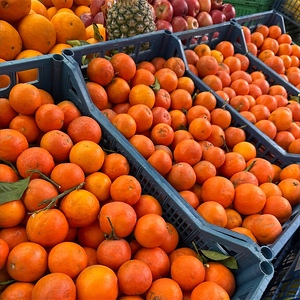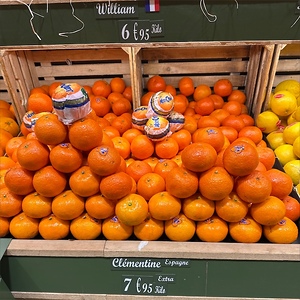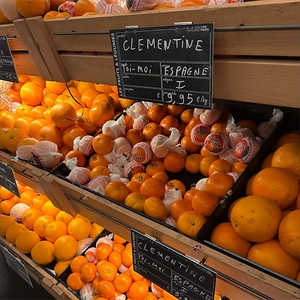


European Clementines
Estimated Inventory, lb : 0
Description/Taste
European Clementines are generally small but vary slightly in shape and appearance, depending on the variety. The fruits typically have a round, oblate, or pyriform shape and are broader in the middle with a flat top and bottom. Some varieties also have a short neck. The rind is characteristically thin, easy-to-peel, and glossy with a smooth to textured surface. The rind is also enveloped in tiny oil glands, creating a pebbled, leathery nature. European Clementines range in color from bright orange to red-orange hues, and the rind is moderately adherent to the flesh when young, occasionally becoming puffy after maturity. Underneath the surface, the dark orange flesh is divided into 8 to 12 segments by thin membranes and is tender, semi-firm, and aqueous with a succulent consistency. The flesh is also seedless or encases a few tapered, oval, ivory seeds. European Clementines contain high levels of essential oils secreted through the glands on the rind's surface, creating a fragrant, fruity, and bright, aromatic scent. The fruits have sugar mixed with low acidity, contributing to a sweet, mild, refreshing taste with subtly tangy, fruity nuances.
Seasons/Availability
European Clementines are available in the fall through early spring, typically between October and April. Most varieties have a peak season from November through January.
Current Facts
European Clementines, botanically classified as Citrus clementina, are a category of small hybrid fruits regionally grown in Europe, belonging to the Rutaceae family. Several varieties are collectively sold under the general Clemetine name in Europe, including cultivars like Clemenules, Oroval, Fina, Clemenvilla, Comune, Hernandina, and many others. There are also regionally protected varieties that bear the prestigious PGI label as a mark of quality. European Clementines are a seasonally popular citrus favored for their easy-to-peel nature, sweet taste, and pleasant aroma. The fruits are transportable and can be carried as an on-the-go snack. Each region in Europe will offer different varieties of European Clementines, and it is common for some cultivars to be wrapped in company-branded tissue as a mark of differentiation. European Clementines are versatile fruits that are primarily eaten fresh, but they are also incorporated into various cooked culinary preparations.
Nutritional Value
European Clementines vary in vitamin and mineral content, depending on the specific species. In general, Clementines may be a fiber source to aid digestion and vitamins A, B, C, and E to produce energy, aid in faster wound healing, strengthen the immune system, and maintain healthy organs. Clementines also provide minerals like calcium, phosphorus, magnesium, iron, potassium, copper, and manganese. Calcium and phosphorus support bone and teeth development, magnesium helps the body control nerve functions, and iron produces the protein hemoglobin for oxygen transport through the bloodstream. Potassium assists the body in balancing fluid levels, copper helps make red blood cells, and manganese contributes to a healthy metabolism.
Applications
European Clementines have a refreshing, sweet, and tangy flavor suited for raw and cooked preparations. They are primarily consumed fresh, either out of hand as a snack or segmented and tossed into green and fruit salads. European Clementines are also used as a topping over dishes like tacos, grain bowls, and ceviche, or combined into parfaits and chilled fruit cups. Try blending Clementines into juices and smoothies, or puree and freeze into homemade sorbet and ice cream. European Clementines are sometimes segmented and coated in chocolate during holiday celebrations as a decadent treat. In addition to raw preparations, European Clementines can be zested and used to flavor baked goods and desserts like cookies, tiramisu, muffins, scones, and bread. The juice can also be used in cakes, crisps, mousse, and other desserts or simmered into syrups, marmalades, and jams. Beyond sweet recipes, Clementines are cooked into glazes for roasted meats, added to stir-fries, or mixed into noodle dishes. They are also used as flavoring in savory mince pies. European Clementines pair well with fruits such as blueberries, pomegranate, strawberries, grapes, herbs like mint, thyme, and rosemary, and nuts like pine, walnuts, and macadamia. Whole, unopened Clementines can be stored at room temperature for up to one week. They can also be stored in the refrigerator for 2 to 4 weeks.
Ethnic/Cultural Info
Clementines are said to have been named after Algerian monk and French Missionary Brother Clément Rodier, who resided in the Oran region at the Péres du Saint-Esprit orphanage in Misserghin. The story goes that the monk spotted a branch in the monastery gardens that bore distinct fruits. Brother Clément was in charge of the orphanage orchards, took the fruits, and spent several years growing and developing them, eventually creating a new hybrid variety in 1902. The new fruits became favored for their favorable characteristics and were named Clementine by the Horticultural Society of Algiers, according to Louis Charles Trabut, a French physician and horticulturist.
Geography/History
European Clementines are believed to be descendants of varieties native to Asia. Clementines are considered a mandarin and sweet orange hybrid, possibly related to Canton mandarins. Over time, mandarin oranges were spread along trade routes into Europe and North Africa, and a hybrid variety that arose as a chance seedling on a tree in Algeria became famously known as the first Clementine. After their discovery, Clementines were planted throughout the Mediterranean and eventually expanded worldwide as a favored, easy-to-peel, sweet-tart fruit. Many varieties have been developed through breeding and are collectively sold under the Clementine name. Today, European Clementines represent the varieties grown in Spain, the largest producer of Clementines in Europe, followed by Italy, Greece, Croatia, France, and Cyprus. Other European countries, especially in the Mediterranean, may also grow the fruit on a small scale. European Clementines are widely available when in season and are exported throughout the continent for sale in fresh markets and through retailers and wholesalers.










